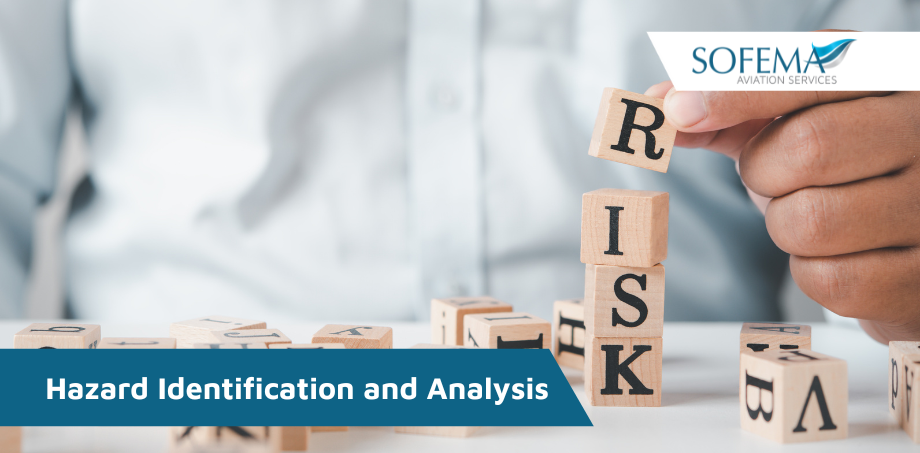Sofema Online (SOL) www.sofemaonline.com considers the elements required for an effective Hazard Identification and Risk Analysis System.
Introduction
We understand that a Hazard is any condition, event, or circumstance defined as “anything” with the potential to cause harm (which could essentially lead to an incident or accident)
o Hazards can have multiple outcomes;
o Zero adverse impact;
o Injury, illness, or death to people;
o Damage to or loss of a system, equipment, or property;
o or damage to the environment.
Delivering Hazard Identification
ICAO Requirements identify that operators and aviation service providers “shall develop and maintain a formal process for effectively collecting, recording, acting on and generating feedback about hazards in operations, based on a combination of reactive, proactive and predictive methods of safety data collection”.
Sources of Data Which Have the Potential to Present Hazards Include:
o Safety Reporting – includes safety occurrence reporting through mandatory and
o voluntary reporting schemes;
o Internal investigation of safety occurrences;
o Safety occurrence trend analysis;
o Information provided by personnel, from operational perspective and training;
o Flight Data Analysis;
o Results from safety surveys and operational oversight safety audits;
o Monitoring of “day-to-day” normal operations and environment;
o Official State investigation results of accidents and serious incidents; and
o Information exchange practices between operators/service providers.
Hazard Identification Methods
Two groups of methods for identifying hazards can be defined:
o Reactive hazard identification methods
o Proactive hazard identification methods
Reactive hazard identification
o Recognised through trend monitoring and investigation of safety occurrences.
Incidents and accidents are clear indicators of systems’ deficiencies and should be therefore investigated to determine the hazards that played role in that event.
Proactive hazard identification
o Hazards are identified by analysing systems’ performance and functions for intrinsic threats and potential failures.
o The most commonly applied proactive methods are:
- Safety surveys,
- Operational safety audits,
- Safety monitoring and
- Safety assessments.
- Flight Data Analysis (FDA),
- Line Operations Safety Audit (LOSA) and
- Normal Operations Safety Survey (NOSS)
Techniques available to identify hazards:
- The “Historic” approach is based on accident and incident investigation and analysis.
o It uses proven investigative techniques to discover all facts pertinent to a past aviation incident or accident, and thus identify opportunities for improvements meant to avoid future, similar accidents.
- The “Diagnostic” approach is targeted at identifying accident pre-cursors within the larger collections of information in various aviation safety reporting systems.
- A “Prognostic” or “Predictive” approach is aimed at discovering future hazards that could result as a consequence of future changes inside or outside the global aviation system, and then initiating mitigating action before the hazard is introduced.
o Prognostic hazard identification informs design processes so that the hazards can be eliminated from the future, avoided future, or mitigated in the future.
Hazard Identification Methodology
Hazard Identification methodology provides for a range of possible sources of failure, with the following examples identified as a starting point:
- Design factors, including equipment and task design;
- Procedures and operating practices, including their documentation and checklists, and their validation under actual operating conditions;
- Communications, including the medium, terminology, and language;
- Personnel factors, such as company policies for recruitment, training, and remuneration;
- Organisational factors, such as the compatibility of production and safety goals, the allocation of resources, operating pressures, and the corporate safety culture;
- Work environment factors, such as ambient noise and vibration, temperature, lighting, and the availability of protective equipment and clothing;
- Regulatory oversight factors, including the applicability and enforceability of regulations; the certification of equipment, personnel, and procedures; and the adequacy of surveillance audits;
- Defences, including such factors as the provision of adequate detection and warning systems, the error tolerance of equipment, and the extent to which the equipment is hardened against failures.
Hazard Classification
A structured approach to the identification of hazards ensures that:
- To the extent possible, all potential hazards are identified and assessed.
- The assessment of hazards should take into consideration all possible outcomes
o From the least likely to the most likely.
o Hazard identification determines to a great extent the effectiveness of an organisation’s risk management process, as it provides the input for the other two risk management components, notably the Risk Assessment and Risk Mitigation.
Next Steps
Follow this link to our Library to find & Download related documents for Free.
Sofema Aviation Services (SAS) provides Safety Management System Consultancy, Classroom, Webinar, and Online Training including the following 3-Day course. For additional details, please see our websites www.sassofia.com and www.sofemaonline.com or email team@sassofia.com
Tags:
aviation, aviation safety, Hazard, Hazard Analysis, Hazard Identification, Risk Analysis, Risk Analysis System, Risk Management, Safety, Sofema Aviation Serices




